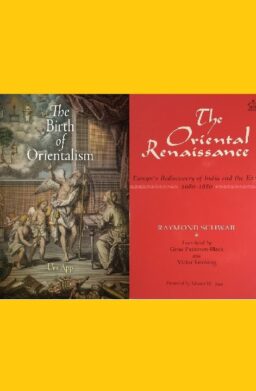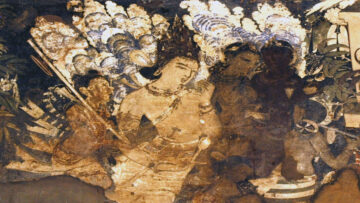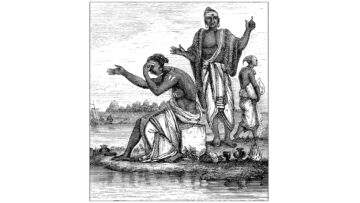Introduction
This review covers two important books on the birth and flourishing of Orientalism: Raymond Schwab’s The Oriental Renaissance: Europe’s Rediscovery of India and the East, 1680 to 1880 (1984) and Urs App’s The Birth of Orientalism (2010). Orientalism in this context refers to the institutionalized study of non-Western cultures by Europe and the huge body of writings produced by such studies. The focus of both these works is Indology/Indian studies in particular. There is a reason why these two books have been chosen as a package for the following book review. Urs App’s The Birth of Orientalism is a lead into Raymond Schwab’s The Oriental Renaissance. The first book charts out key developments, ideas and findings in the preceding centuries, which would lead to the establishment and flourishing of Indology in the nineteenth century. The latter book is about the key time period of the nineteenth century, in which Indology came into being as a formal discipline, and many of the foundational commonsense concepts and ideas about India and Hinduism were established. This article serves as both a review and comparison of both books and what readers of IndicA Today can take away from these books.
Setting the Stage
It was on August 14, 1947 that Jawaharlal Nehru, the then Prime minister of India, delivered his speech on India’s tryst with destiny. On August 23, 2023, India landed its first satellite on the south pole of the moon. It is no exaggeration to say that we have come a long way since 1947. At the time of independence, India was a poor agrarian society, with over eighty percent of its population living below the poverty line, electrified homes were the luxury of a privileged few; most of the population was malnourished (Guruswamy, 2022). India at that time was heavily dependent on aid from foreign countries. Today, India is a rising power in multiple domains; economically, militarily, and politically. It is the fastest growing economy in the world according to the World Bank, and set to become the third largest economy in the world by 2050 (Livemint, 2023, World Bank Group, 2023). It recently hosted the G20 summit, and as mentioned before, landed a satellite on the moon. Today’s generation of Indian youth are more confident and ambitious than their predecessors, both in terms of their individual ambitions, and their aspirations for India to become a major ‘player’ on the world stage. The subservient colonial inferiority complex that the previous generations of Indians had towards the West has subsided among the current generation.
At the same time, the India of today has its own internal problems, such as political corruption, poor infrastructure, and a higher education system that is seriously in need of a revamp. In the international arena, India is part of a tumultuous and fast changing world to say the least. India has had to deal with an aggressive, expansionist China, that has emerged as the foremost power in Asia over the last decade, rivalling the United States as a superpower. In addition, India, like other nations, has contended with a series of crises that have defined the twenty first century world: from economic recessions, to a pandemic, to wars. These crises have created an unstable political and economic world order. In these uncertain times, today’s Indians are confronted with the questions: What is India’s tryst with destiny? Who are we as Indians? What does India of today have to offer to the world at large, not only as a nation but as a culture?
The rise of China and India has been accompanied by the decline of the United States and the West. The crises mentioned above have precipitated the loss of the clout and influence of the United States as a world power, and a loss of confidence in Western international institutions in general (United Nations, World Trade Organization etc). The international rules based liberal world order that the United States sought to create is fast becoming a distant memory. While America’s decline as the dominant global superpower began at the start of the twenty first century, Europe’s position as a dominant power, ended for the most part at the conclusion of World War II. Most of the European nations lay in shambles. Having lost their colonies, many of their cities lying in ruins because of the war. To their credit, Europeans did an admirable job rebuilding their societies, establishing robust welfare, healthcare, and education systems that continue to provide an excellent quality of life for their citizens. But the fact remains that European hegemony in world affairs ceased after the Second World War, and Europe’s influence in world affairs has also markedly reduced; whether it be in the field of economics, education, or politics.
When one looks at the Europe of today, and compares it to the Europe at the beginning of the nineteenth century, the difference could not be more striking. Europe of today is economically dependent upon and torn between the competing interests of other powerful nations (United States, Russia, China). The 2008 global financial crisis, combined with the recent covid crisis and the Ukraine War have put a strain on the economy, and consequently, the political stability and social security systems of the European countries.
On top of these problems, European countries are faced with an aging population and a Middle east migrant crisis that have also put a strain on their economy and social security. Many Europeans feel that the migrant crisis threatens the cultural and demographic makeup of their countries. As a result, Europe has grown more insular, and Europeans are undergoing an identity crisis. Today’s Europeans are confronted with similar questions that present day Indians face: Who are we? What is Europe’s role in today’s world?
The Birth and Development of the Oriental Renaissance: Previewing the Structure of Both Books
Today’s Europe is a far cry from the Europe of the nineteenth century, which had colonized most of the planet. Nineteenth century Europe was a dynamic and intellectually vibrant society that produced philosophies, ideologies, and scientific innovations that reshaped and transformed the world.
This was a Europe that was confident and self-assured. It knew what its role and mission in the world was, namely, to bring civilization, science and true religion to the rest of the world. European travels during the preceding three centuries had exposed it to new and exotic cultures and landscapes that it had never encountered before. Europe’s intellectuals were excited by the possibilities of what they could learn from these newly discovered cultures and peoples. Of all the cultures they encountered, very few excited and intrigued them as much as India.
Europe’s intellectuals thought that contact with India would generate a second intellectual renaissance for Europe, similar to how the rediscovery of Greco-Roman texts in thirteenth century Europe was supposed to have generated the first renaissance[1]. The discovery of ancient Sanskrit texts by European scholars gave birth to the notion (for the first time in their minds) that there existed an advanced civilization apart from the European one. Up to that time, biblical antiquity was thought to be the most ancient past. The discovery of the Sanskrit language and Sanskrit based texts changed the European conception of chronology and history. Here was a living culture (the Indian culture) whose heritage and philosophies were every bit as rich, if not richer than, that of the ancient Greco-Romans.
Starting from the end of the eighteenth century up to the second half of the nineteenth century, an ‘Indomania’ of sorts exploded in the intellectual circles of Europe. William Jones’ tracing of the antiquity of Sanskrit and the relationship between Sanskrit and the European languages was one of the major starting points. Following this, Oriental Studies and Indology exploded in Europe. We see the establishment of the Royal Asiatic Society, and Sanskrit and Indology departments being opened in different universities across Europe. There was an intellectual energy in the air that wasn’t there before and hasn’t been seen since in Europe. Europeans from different intellectual backgrounds and nations were all convinced that there was something profound to learn from India about humanity as a whole, which would rejuvenate Europe intellectually, and breathe new life into the native philosophies and theologies of Europe. It is important to note that most of the well known ideas and concepts about Hinduism today, that are commonly accepted by opponents and proponents of Hinduism alike, developed and became firmly entrenched during this formative period in the nineteenth century.
Now we come to the question: What did these men think they could learn from India? What were the questions and problems they were grappling with? Why did they think that Indian/Sanskrit texts could provide them with the answers they were looking for?
Both The Oriental Renaissance and The Birth of Orientalism provide answers to these questions, but the latter book does a better job of addressing these questions than The Oriental Renaissance as I show below.
The Oriental Renaissance: Europe’s Rediscovery of India and the East, 1680 to 1880 (1986)
The Oriental Renaissance is a book written by the French writer Raymond Schwab. The original book was written in French and translated into English by Gene Patterson-Black and Victor Reinking. It is comprised of a total of four hundred and eighty six pages from the beginning of the introduction to the end of the final chapter. It contains a total of twenty six chapters, which in turn are further divided into seven parts, including the conclusion. One way of describing this book is that it is about the history of Indology from the late eighteenth century up to 1875. One might ask why the author has chosen the cutoff date of 1875, when Indology continued long after that date up to the present day. According to Raymond Schwab, even though Indology might have continued past 1875, the dream and vision of an Oriental renaissance faded. And that in essence is the subject of the book: the historiography of an intellectual movement, of the events that occurred during this fervent period, whereby a broad intellectual cross section of Europe thought that the ultimate questions about humanity and the meaning of human history can be answered by studying India, her philosophy and religion. It was this impetus that led to the institutionalization of Indology and Oriental studies as a discipline.
The first three parts of the book, which consists of eight chapters, narrates the history of Indology and the Oriental Renaissance by focusing on four important components that would shape the development of the Oriental Renaissance: the discovery of the Sanskrit texts, institutes of Oriental and Indian studies, the important Orientalists who shaped the Oriental renaissance, and the ideas and questions that shaped the European conception of the so called Hindu religion. The introduction and first chapter deal with the idea of the Orient in the Western mind, and their hopes of an Oriental renaissance. These chapters do a good job of capturing the intellectual excitement and energy of the nineteenth century Orientalists. In India, in her ancient Sanskrit texts, they thought they had found the answer to the most profound questions about human beings and human history. The first chapter also gives some inkling of the intellectual concerns and preoccupations of the nineteenth century philosophers and orientalists.
The second and third chapters of the book is about the ‘discovery’ of the ancient Sanskrit texts, the relationship between Sanskrit and other European languages, and the establishment of the Asiatic society of Bengal. The Royal Asiatic Society would play a key role in the creation and dissemination of Orientalist writings about India. Chapters two and three introduce three key figures who were responsible for building and shaping Indology and Oriental studies in its initial stages: William Jones, Charles Wilkins, and Henry Thomas Colebrooke. These two chapters also introduce three important ideas that became popularized during this period, namely, the Vedas as the sacred scripture, Sanskrit as the sacred language, and Brahmins as the priestly caste of the Hindus. These concepts became the important foundation blocks on which the European construction of Hinduism was built upon. Eventually, the popularity of Indology and Oriental Studies dwindled among the British, for a number of reasons, and France and Germany became the hub of Indic studies.
In Chapter three, Raymond Schwab, goes as far as to call Germany as the birthplace of the Indic Renaissance, and discusses two important intellectuals who would set the course of German Indology: the theologian and philosopher Johann Herder and the philosopher and Indologist Friedrich Schlegel. Both of these men believed that India was the primitive fatherland of the human race, the birthplace of the original revelation of God. This would eventually lead to the theory of the Aryan race, which in turn would have enormous repercussions on the development of German nationalism and philosophical systems. As Schwab says, “It is difficult to imagine any of the great German philosophical systems if one subtracts the [oriental] element.” (Schwab et al., 1987, p. 15). As anyone familiar with Indian history knows, this story about the primordial pure Aryan race and religion would also have an enormous impact on how we view Indian history, and the development of Indian nationalism and politics.
Chapters Four and Five trace the development of French Orientalism, particularly on the birth of the Société Asiatique of Paris and the dissemination of Orientalist writings through this institute. Schwab claims that after Germany, Paris became the hub of Orientalism, and even many of the renowned German Indologists like Friedrich Max Muller and Friedrich Schlegel had their intellectual growth and maturation in Paris.
Chapter six in my opinion, is the most interesting chapter in the book. It traces the crystallization of the concept of Hinduism as the religious system of India within Oriental studies. The so called Indian doctrines served as the material through which the Orientalists developed their concept of Hinduism. The Orientalists could not imagine texts such as the Vedas and the Dharmashastras as anything other than the doctrines and religious laws of the Hindus. The missionary Abraham Roger was instrumental in creating the basic, fundamental concept of Hinduism that we find in many books about Hinduism: The Hindus have multiple sects. All the sects recognize one sovereign God which they worship in many forms. Therefore the so called outward polytheism of the Hindus hides a monotheistic doctrinal core. He also talks about two conflicting doctrines in the Indian religion: one in which the soul and God are one, and the other in which the soul and God are separate. This is Abraham Roger describing the Advaita and Dvaita schools of thought within the Indian traditions. Roger was also the first Westerner to describe the Vedas as the sacred doctrine and laws of the Indians, created by the Brahmins who are the priests of the Indian religion, and written in ‘samscortam’, the sacred language of the Indians.
Friedrich Schlegel is once again brought up in chapter six. He was one of the first Europeans to conceive of the Indian religion as the original revelation of God to mankind, that has been altered and misunderstood. This understanding of Indian religion as an altered and corrupt revelation would determine much of the understanding of Hinduism, the caste system, and the role of the Brahmins, among European Indologists. In many ways, it became the driving force behind the study of Indian religion and the hopes for an Oriental renaissance.
Chapter seven describes the growth and development of philology and comparative linguistics and its relation to Oriental studies. Ever since the time of the early Church fathers, the multiplicity of languages was seen as a religious problem. According to the Bible, at one time, humanity lived as one and spoke one language, but God confused their language so that they couldn’t understand one another, and scattered them across the earth as punishment for their pride (human beings tried to build a tower known as the tower of Babel in order to reach heaven). One humanity became divided into many nations, each defined by their own language. Many theologians saw the fracturing of the universal language of humanity into many languages, as corresponding to the corruption of the original true religion/revelation of God into multiple idolatrous religions. They thought the recovery of this primitive language would result in the recovery of the original uncorrupted revelation of God. With Sanskrit, many Europeans thought that the original language, or at least the closest living descendant of the original language of humanity, had been discovered; and it would only be a matter of time before the original true religion was discovered. It was out of this endeavour that comparative grammar and linguistics was born. By tracing the history and genealogy of languages, philologists hoped to uncover the history and genealogy of nations and the historical development of religion.
The rest of Schwab’s book is about important intellectuals and literary writers who contributed to and were influenced by French Orientalism. Part five focuses entirely on French novelists and poets who were influenced by Orientalist writings about India, and incorporated themes from those writings into their novels and poems.
The Birth of Orientalism (2010)
Urs App’s The Birth of Orientalism is about important ideas and findings that emerged from European encounters with India during the century of enlightenment. These ideas and findings are important because they lay the groundwork for Indology and the idea of an Oriental Renaissance. Unlike Schwab’s book, App’s work isn’t a historiography. It is rather, a focused systematic study that concerns itself with the questions I raised earlier: Why were these Orientalists interested in India and her Sanskrit texts? What were the questions and problems that drove them? In the author’s own words:
‘’The present book does not claim to furnish a history of Orientalism as a whole. Its much more modest aim is to elucidate through relatively extensive case studies a crucial phase of the European encounter with Asia: the century of Enlightenment’’ (App, 2010, p. xi)
These case studies are about select European intellectuals and their encounters with India and her so called religious texts. These encounters would lead to information and ideas about India, which became the base to launch Oriental studies and Indology in the nineteenth century. Specifically, it is about Europe’s conceptualization and description of Asian religions during the century of enlightenment. It is at this point that one might object that there is no such thing as a ‘European’ description of Asia and India. Each of the encounters with India was unique, with different people, at different times, in different contexts. However, as the book shows, there were a set of common ideas and themes shared between these intellectuals that structured and guided their study of India and her texts. These common ideas and themes, as the author elucidates wonderfully throughout his book, were derived from within the ambit of Christian theology. As the author explains in the beginning of his preface, religion played a far greater role in the birth of Orientalism than colonialism. The institutionalized Orientalism in the beginning of the nineteenth century was the successor of earlier forms of Orientalism. ‘’Premodern academic Orientalism was generally a handmaiden of Bible studies and theology’’ (App, 2010, p. xii). This explains its almost exclusive focus on language and religion when studying different cultures. Before the nineteenth century, most studies of Oriental texts and languages happened in the context of Christian missions. Urs App notes that even by the time of the nineteenth century, Orientalist studies weren’t free from its Christian roots. Fundamental views about where we come from, human nature, and history were all interconnected and derived from different Christian theologies. These views played an extraordinary role on how Europeans experienced India. Each case study involves a European intellectual, whether he be a philosopher or missionary, and their encounters with India and Indian texts. All these intellectuals played a significant role in the genesis of modern Indology and shaped how the West viewed India. Urs App traces some key ideas shared by these figures that directed their study of the so called Indian religions and their text. One of these ideas is the differentiation between the exoteric and esoteric forms of religion, with the exoteric being the outer form of the religion and the esoteric being the inner doctrine and philosophy of the religion, with the exoteric being perceived as a corrupt degenerate form of the esoteric. It was this idea that led to the differentiation of Hinduism into the high philosophical Hinduism versus the popular Hinduism of the masses. Another important idea is the Biblical view of human history, in which religion played a central role. All the nations of the world were seen as the descendants of the three sons of Noah, and the different traditions and practices of different peoples were seen as false religion, corrupt variants of the original pure monotheism that was revealed by God to Adam. This brings us to the most important idea that the author stresses throughout the book in his case studies; the concept of a primordial pure monotheism that existed before Christianity. Most, if not all the figures discussed in the book believed India was the birthplace of this pure monotheism, which later became corrupted into idolatry because of the Brahmin priesthood. This book explores a diverse set of persons in its case studies, from the famous French enlightenment philosopher Voltaire, to the German Protestant theologian Ziegenbalg, to the pioneering freemason, Scotsman Chevalier Andrew Ramsay. Excluding the notes, bibliography, index, and list of figures and tables, the book comes to a total of four hundred and ninety pages.
To be Continued….
Disclaimer: The opinions expressed in this article belong to the author. Indic Today is neither responsible nor liable for the accuracy, completeness, suitability, or validity of any information in the article.










